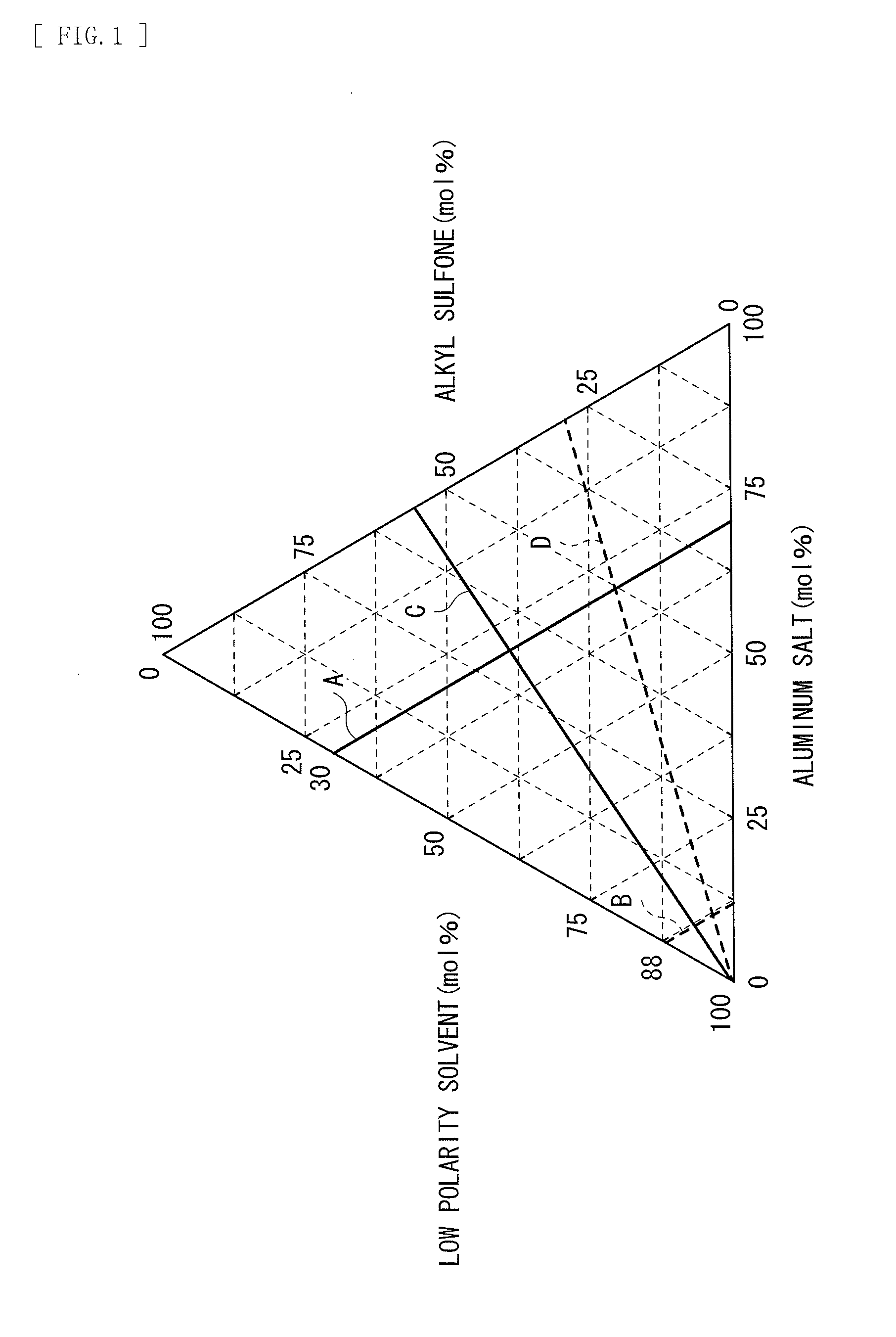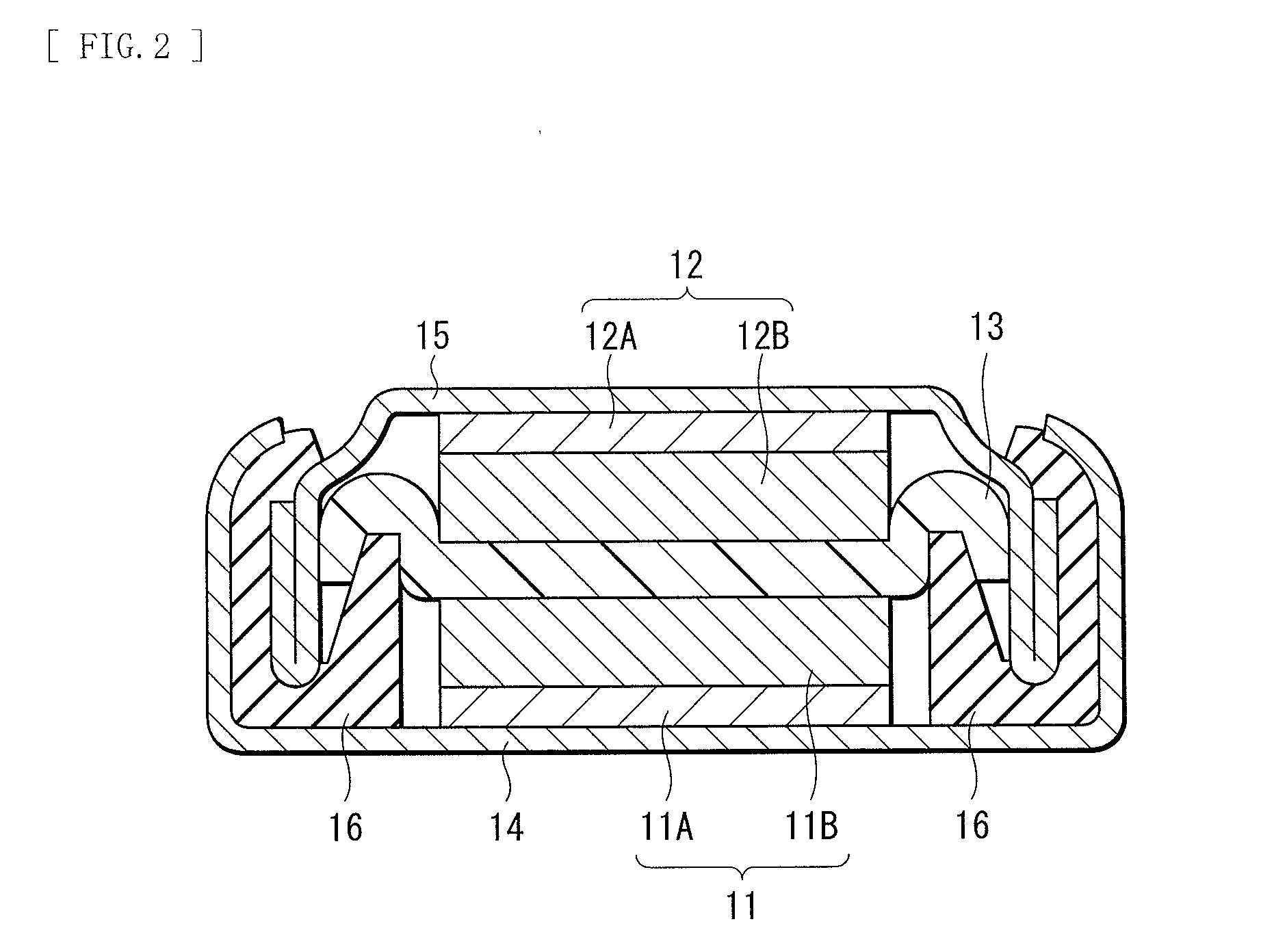Electrolyte and secondary battery
a secondary battery and electrolyte technology, applied in the field of electrolyte and secondary batteries, can solve the problems of low reaction efficiency, achieve the effects of reducing the progression temperature of the precipitation-dissolution reaction of aluminum, facilitating generation, and effectively precipitating and dissolving
- Summary
- Abstract
- Description
- Claims
- Application Information
AI Technical Summary
Benefits of technology
Problems solved by technology
Method used
Image
Examples
examples
[0062]ext, Examples of the present invention will be described in detail.
examples 1 to 18
[0063]A low polarity solvent (toluene: TOL) and an alkyl sulfone (ethyl-n-propyl sulfone: ENPS) were mixed. Thereafter, an aluminum salt (aluminum chloride: AlCl3) was dispersed to prepare liquid electrolytes (electrolytic solutions). In this case, the mixture ratio of the foregoing three components was adjusted so that compositions illustrated in Table 1, that is, contents of the low polarity solvent and mol ratios (the content of the aluminum salt / the content of the alkyl sulfone) illustrated in Table 1 were obtained. When the electrochemical characteristics of the electrolytic solutions were examined, results illustrated in Table 1 were obtained. In Table 1, as content values of the respective components, values rounded to two places of decimals are shown.
[0064]As the electrochemical characteristics, first, progression degrees of precipitation-dissolution reactions of aluminum were evaluated by using each electrolytic solution (2 cm3). Specifically, a current flowing at the time ...
examples 19 to 28
[0068]As shown in Table 2, electrolytic solutions were prepared and the electrochemical characteristics thereof were examined by a procedure similar to that of Example 6 except that types of the low polarity solvent and alkyl sulfone were changed. In this case, as low polarity solvents, benzene (BEZ), o-xylene (OXY), m-xylene (MXY), p-xylene (PXY), and 1-methyl naphthalene (MN) were used. Further, as alkyl sulfones, ethyl-i-propyl sulfone (EIPS), ethyl-n-butyl sulfone (ENBS), ethyl-i-butyl sulfone (EIBS), ethyl-s-butyl sulfone (ESBS), and di-n-propyl sulfone (DNPS) were used.
TABLE 2CompositionLowpolarityAluminumAlkylsolventsaltsulfoneEvaluationContentContentContentmol2560Type(mol %)Type(mol %)Type(mol %)ratiodeg C.deg C.Example 6TOL62.32AlCl321.53ENPS16.154 / 3∘∘Example 19EIPS∘∘Example 20ENBS∘∘Example 21EIBS∘∘Example 22ESBS∘∘Example 23DNPS∘∘Example 24BEZ62.32AlCl321.53ENPS16.154 / 3∘∘Example 25OXY∘∘Example 26MXY∘∘Example 27PXY∘∘Example 28MN∘∘
[0069]Even if the types of the low polarity s...
PUM
| Property | Measurement | Unit |
|---|---|---|
| specific dielectric constant | aaaaa | aaaaa |
| specific dielectric constant | aaaaa | aaaaa |
| temperature | aaaaa | aaaaa |
Abstract
Description
Claims
Application Information
 Login to View More
Login to View More - R&D
- Intellectual Property
- Life Sciences
- Materials
- Tech Scout
- Unparalleled Data Quality
- Higher Quality Content
- 60% Fewer Hallucinations
Browse by: Latest US Patents, China's latest patents, Technical Efficacy Thesaurus, Application Domain, Technology Topic, Popular Technical Reports.
© 2025 PatSnap. All rights reserved.Legal|Privacy policy|Modern Slavery Act Transparency Statement|Sitemap|About US| Contact US: help@patsnap.com



